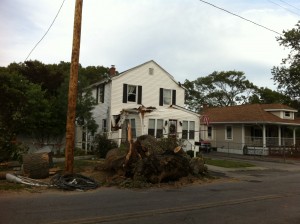In Prepare for the Worst, Plan for the Best: Disaster Preparedness and Recovery for Small Businesses, I wrote of the insights gleaned from examining the patterns of human error that impact your business. If your management style is to wait until the last minute to complete work and create needless stress, human errors will increase. Changing your management practices to allow for adequate preparation and response times will reduce the frequency of human errors – and improve your overall mental health! Today I learned the corollary to that piece of advice when I had difficulty accessing an online form for the Community College of Rhode Island (CCRI). CCRI’s website and applications were accessible only to those using terminals on campus. I am working with a non-profit organization that sought to apply to participate in CCRI’s Annual Day of Service in which students volunteer to perform a day of work for local charities. The deadline for application is January 6. Had I waited until tomorrow or the day after, my stress levels would have been rising with each hour that I was unable to complete the online application. Fortunately service was restored by the close of business and we submitted our materials two days in advance. But the next time, I will pencil the dates in my calendar for one week in advance of the actual deadlines.
Archive for the ‘Everyday Disaster’ Category
Better Project Management to Minimize Risk
Monday, January 4th, 2016Spring Forward and Fall Back
Sunday, November 1st, 2015It is that time of year again when we turn the clocks back one hour and prepare for shorter days. The act of turning the clock back one hour in the fall and advancing it one hour in the spring is a helpful reminder to check your smoke and carbon monoxide detectors. You should both verify that they are functioning properly and insert new batteries. Remember to do this for both your home and your place of work. Remind your employees to do the same for the safety of their families and homes.
I nearly learned this lesson the hard way as I recently rented a town home with an option to purchase it. I practice what I preach and so replaced the batteries twice yearly. It was not until I had a home inspection performed, in connection with my interest in purchasing the property, that I learned that fresh batteries didn’t help, as the smoke detectors were defective.
The home inspector also surfaced other safety hazards that are serious violations of the local housing code and documented them in a 49-page report. These hazards were not visible to me so I had no idea of the risks to which I was exposed. In particular, the inspector found that the hot water heater had been installed by an unlicensed contractor working without the required permit and that the appliance was recalled by Sear’s for having a defective valve. The homeowner’s unlicensed contractor didn’t install it properly and it leaked carbon monoxide. The homeowner/landlord also ignored repeated communications from Sears offering to replace the hot water heater at no charge. (The inspector and I verified that Sears did have the correct contact information for the landlord. Of course, to be clear, Sears had no way of knowing that the landlord did not properly install the appliance and caused other health hazards. Sears was certainly not at fault.)
As CO exposure kills red blood cells, a simple lab test can determine the volume of dead red cells circulating in the bloodstream. So my primary care physician ordered tests to check for carbon monoxide poisoning and for blood lead levels. Investigation revealed that this particular hazard existed for eight years. One of the previous tenants in the property was a divorced dad with custody of three children, children who were unknowingly breathing in carbon monoxide – not enough to kill them, but enough to cause symptoms. It is a scary thought that you have to extra diligence as not all states require rental permits to verify that tenants are safe. I wanted to share that experience to show why you cannot be too careful.
The Value of Mutual Assistance
Tuesday, August 4th, 2015A severe thunderstorm struck Rhode Island at about 6:30 this morning, knocking out trees, flooding roads and leaving more than 120,000 residents without power, more than were left without power following Superstorm Sandy. The storm brought wind gusts of 80 miles per hour, along with quarter-size hail and intense lightning strikes. I took this photograph of a nearby home that was damaged when a tree fell on it. I took this picture when it was safe to do so, in the evening, after most of the tree had been removed. By mid-afternoon, you could heat the sounds of chain saws cutting up fallen trees.
National Grid, the local utility company, reported that the storm had knocked out power to 20 major power lines that serve 12 substations, 70 main distribution lines, and hundreds of power lines and equipment on local streets and in neighborhoods. The company sent 300 line crews, 110 tree crews, and 90 wires down/”cut-and-clear” crews to work with the electric grid to turn the power back on. Then National Grid reached out to its partners in the North Atlantic Mutual Assistance Group, a group formed to enable its 33 member utility companies to assist one another in the event of an emergency. Utility crews from eight northeastern states came to Rhode Island to assist in the efforts to restore power. The mutual assistance framework now crosses national boundaries as well.
Hydro-Québec sent 60 employees, including 50 line workers as well as technical and logistics personnel, from Canada to Rhode Island to help National Grid crews. This was not the first time Hydro-Québec crews crossed the U.S. border to help the response to a severe storm. In January, the company sent 50 crews to Boston to assist after a severe blizzard. The mutual assistance framework provides a mechanism for the company requesting assistance to pay the costs of the utility companies that respond to the call for help and coordinates the logistics to avoid delays in responding.
We also saw informal mutual assistance in action as neighbors helped one another clear trees and remove debris well before responders could access the roads. I work with a virtual assistant who was accessible via cell phone. She re-scheduled my appointments for the day as it was impossible to leave my home. And I had my laptop and tablet fully charged so I was able to continue working and help others who were unable to place calls. The severe storm reminded me that it is time to update my own mutual assistance framework for my business.
What Is Your Risk Tolerance?
Monday, July 20th, 2015Marketing guru Seth Godin posted a blog entry today about the paralyzing consequences of irrational fears, such as shark attacks (which, notwithstanding television news stories, are extremely rare events). He advises that it is “better to prepare for a hazard both likely and avoidable instead”. His comments were in the context of taking on challenges by setting aside irrational fears but, of course, are exactly consistent with the advice given in Prepare for the Worst, Plan for the Best: Disaster Preparedness and Recovery for Small Businesses. It is a mistake to focus your attention on high-severity, low-frequency risks, such as hurricanes and earthquakes as the fear can be paralyzing. Better to prepare for the “everyday disasters”, such as human errors, computer crashes, fires and the like. This approach provides an immediate benefit against a more imminent threat at a more reasonable cost. And it gradually builds resilience against the more severe, but less likely, threats.
Attorney Brett Dawson offered his take on risk tolerance at a legal workshop for small businesses at the SCORE (Service Corps of Retired Executives) “Learn to Soar” program in Rochester, NY earlier this month. I have pages of notes from that workshop to capture his helpful insights from years of advising small business owners. He said that many business owners tend to dismiss risks as “unlikely as being struck by lightning.” But, in fact, 2500 people are struck by lightning each year in the United States and 60 of them die. While being struck by lightning is not likely to happen, it is not a non-zero risk, the point being, if there is a risk, however negligible, that you can eliminate, do so, as there is no benefit to assuming it. Whether your point of reference is a shark attack or a lightning strike, a pragmatic approach to risk tolerance is best.
Digital Spring Cleaning
Monday, May 7th, 2012In addition to the usual housekeeping tasks associated with spring cleaning, I am completing a digital cleaning project for my business. It doesn’t provide the same sense of satisfaction as routine housework in that I don’t have the gratification of seeing clutter or dust removed. But when I sit down to work at my computer, I feel a sense of calm that comes from order. I recommend this process for all small business owners. It facilitates your business continuity planning, since you will only be backing up and tracking the files and applications that you actually need and regularly use. I began my removing software applications that I no longer use, thereby ending the obligation for their licensing fees. I made certain that all of my current software applications are up to date. I organized my digital media files, including audio, video and graphics, with a tagging system for more efficient retrieval. In case of duplicates, I retained the highest quality file. I made certain that all of my directory and contact information is up to date, streamlined my databases and confirmed my file taxonomy so anyone can find a file without reading my mind. I also deleted all of the junk files. It is great to sit down to the computer in apple-pie order. Next, I am organizing my home and personal files in the same manner. I am also doing the more conventional cleaning and de-cluttering tasks. I have sold or donated over 1,200 books, some of which I have had since high school. One month later, I cannot remember which ones are gone, that is how infrequently I consulted them. I read that one reason for the popularity of e-readers in Japan is that they enable large libraries in small homes. I already feel lighter. This photograph, by the way, is of lilies of the valley that are now ubiquitous in my neighborhood. The lilies and the clean home and office are a sign that spring has arrived.
Hospital Closure Devastates Local Businesses
Tuesday, September 21st, 2010Since St. Vincent’s Hospital closed its doors, its 3,500 employees, patients and their visitors are no longer patronizing small retail businesses in the hospital’s immediate vicinity in Lower Manhattan. The Greenwich Village-Chelsea Chamber of Commerce reports that the hospital’s closure has resulted in 40 – 50% declines in operating profits among small businesses in the city blocks around the old hospital site, with one business reporting a revenue decline of 80%. State Comptroller Thomas DiNapoli met with neighborhood businesses to make them aware of small business loans available through the comptroller’s New York Business Development Program. I think that there are three takeaways from this experience. The first is the risks to small businesses that lack a diversified customer base. The second is that our paradigm of disaster is outdated, focusing on physical damage as a measure of economic losses. In fact, in our service economy there need not be a correlation between physical damage and economic losses, as this example illustrates. Finally, our policymakers need to understand that debt is not the answer to every problem. With revenue declines of 40 – 50%, how are these small businesses to repay the loans they are being encouraged to take out? Borrowing to continue a lifestyle that is no longer sustainable will only make matters worse for the small business owner.
Commuter Disaster
Wednesday, August 25th, 2010From time to time we are reminded of the costs of our failure to maintain our public infrastructure. The mass delays on Amtrak and the Long Island Railroad provided another timely reminder. The disaster began on Monday morning when a fire destroyed train switches of the LIRR. The fire was quickly extinguished, but nevertheless crippled the entire commuter train system. One third of the scheduled trains were canceled, but the inconvenience of rebooking and lengthy travel delays is insignificant relative to the risk of passenger or worker injury due to human error. The New York Daily News reports that train workers are manually operating the machinery that keeps the trains on the tracks, working back-t-back shifts until the equipment is fixed. Isn’t that scary? That problem was followed by a major voltage outage affecting the entire Northeast Corridor. Many Long Island commuters had to book hotel rooms to spend the night in the city, as they could not get safely home. As these incidents become more and more frequent, we have to explicitly consider the cost of doing business in major U.S. cities. I took this photograph when I lived in Switzerland. It is the Cisalpino, the high-speed train I used to take between Zurich and Milan. It runs like clockwork.
Fragile Urban Infrastructures Require Flexible Response
Thursday, January 7th, 2010This is the time of year when I most miss living in Switzerland. My friend took the attached photograph of blizzard conditions in London for which the city is never prepared. Public transportation and all other essential services grind to a halt with such weather. Businesses need to plan for workers to telecommute from home. This necessarily requires explicit procedures for the use of company-issued laptops. Laptops should be used for business purposes only, as surfing popular consumer sites through the Internet browser expose the business to more risk of malware and other intrusions. Exercise special care for file storage, as you want to discourage saving files to the hard disks of laptops where they can be lost or damaged. The use of a virtual private network will allow secure access to company computing facility and proper backup of files across the network. When the forecast is unclear, encourage telecommuting to keep employees from traveling on unsafe roads. Advance planning will limit the impact weather-related disruptions on your business.
Power Outage Delays New York Trains
Wednesday, December 23rd, 2009This is the time of year when I miss Switzerland the most. It is not just the beauty of Zurich, decorated with holiday lights for Christmas. It is the efficiency of the Swiss train system. You can set your watch by the arrivals and departures of the trains. Today an electrical problem outside New York City stopped Amtrak train service for three hours, stranding thousands of holiday travelers. The good news is that during the outage trains en route to New York had on-board power for heat and lighting, which isn’t always the case when the route loses power. The disruption delayed service up and down the East Coast, including commuter traffic on New Jersey Transit, a local rail line. I now expect such disruptions and plan for them as a routine matter. One tip for train travel, particularly if you take the train to Washington or Boston for business, as I often do: make sure your laptop is fully charged when you board. Keep it charged by choosing a window seat. Then if the power goes out, you have another three or so hours left on your battery. I also pack snack food as the café car will always run out of food, and the choice isn’t particularly appetizing anyway. Finally, call for your ground transportation on your cell phone as you approach the station. There is generally limited parking space at Amtrak city stations and with long delays, you can’t plan for a timely arrival.
Snow Disruptions
Monday, December 21st, 2009A winter storm struck the East Coast this weekend, leaving up to two feet of snow, on what is traditionally the busiest shopping weekend of the holiday season. I hope your contingency plans included telecommuting for staff who could do so and e-commerce for your own shopping and for serving your home-bound customers. Airlines are rebooking passengers who were ticketed on canceled flights. According to flight logistics experts, the airlines need three days to rebook passengers and catch up for a single day of cancellations. A storm of this magnitude may require as many as five days. Of course, this bumps the displaced passengers against holiday travelers on one of the most congested travel times of the year. So from travel disruptions to lost sales, a snow storm can have major consequences for your business.







